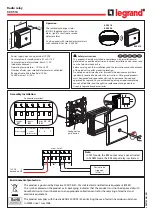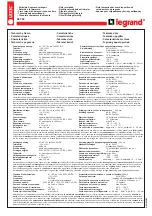
Front Panel Controls – 3
3–3
EXIT Button
Use the EXIT button to exit from a displayed
screen and return to the immediately preceding
menu.
ENTER Button
The ENTER button is used to choose a highlighted
menu selection, to replace a setpoint or other
programmable value with the currently displayed
value, or to select one of several displayed options,
such as ENABLE or DISABLE a function.
ROTARY Knob
Use the rotary knob to increment (by rotating
clockwise) or decrement (by rotating counterclock-
wise) a value currently displayed. (This new val-
ue is not stored and does not affect the unit’s
calculations until ENTER is pressed.) For values
with a large range, use the left/right arrow but-
tons to move the cursor (an underline) to any
digit. Incrementing and decrementing will then
start with the underlined digit.
You can also use the rotary knob instead of the
left/right arrow buttons to choose among menu
selections displayed on the LCD.
3.2
Target/Status Indicators and Controls
The target/status indicators and controls consist
of the POWER and RELAY OK LEDs, the FAULT
RECORDED and BREAKER CLOSED LEDs, the
twelve target LEDs, and the TARGET RESET/LAMP
TEST button.
POWER LED
The green POWER LED indicator will remain lit
whenever power is applied to the unit.
Relay OK LED
The green RELAY OK LED is under control of
the relay's microprocessor. For units having
software version 4.00 and above, you can program
this LED either to flash or to remain on continuously
when the relay is functioning properly. To make
this selection, go to the SETUP UNIT menu, use
the right-arrow button or rotary knob to display
the RELAY OK LED FLASH menu, and select
either DISABLE or ENABLE.
Fault Recorded LED
The red FAULT RECORDED LED will light to
indicate that fault data has been recorded in the
unit’s memory in response to a 52b breaker open
status, if the fault recorder has been armed. You
can arm or disarm the fault recorder using the
FAULT RECORDER menu selection.
Breaker Closed LED
The red BREAKER CLOSED LED will light to
indicate when the breaker status input (52b) is
open.
TARGET Indicators and Target Reset/Lamp
Test Button
Normally, the twelve red target LEDs are not lit.
If the unit trips, the LEDs corresponding to the
cause(s) of the trip will light and stay lit until
reset. Pressing and releasing the TARGET RESET/
LAMP TEST button will momentarily light all LEDs
(providing a means to test them) and reset the
target LEDs if the trip condition is not present.
Detailed information about the cause of the last
five trips is, however, retained in the unit’s memory
for access through the display via the VIEW
TARGET HISTORY menu.
Pressing and holding the TARGET RESET/LAMP TEST
button will display the pick up status of the relay
functions.
3.3
Serial Interfaces (COM 1 and COM 2)
The SERIAL INTERFACE COM 1 port is a standard
9-pin RS-232C communications port. This port
will normally be used for local setting and
interrogation of the relay via a portable computer.
An additional port, COM 2, is available at the
rear of the relay. This 25-pin port will normally be
used for remote setting and interrogation of the
relay via a modem and a compatible
communications protocol. Detailed information on
the use of the communications ports is provided
in Appendix C, Communications and the M-0429A
BECOCOM
®
/M-0428A BECOPLOT
®
User’s Guide.
Summary of Contents for M-0420
Page 56: ...M 0420 Instruction Book 3 4 This Page Intentionally Left Blank ...
Page 92: ...M 0420 Instruction Book 5 28 This Page Left Intentionally Blank ...
Page 156: ...A 8 M 0420 Instruction Book This Page Intentionally Left Blank ...
Page 160: ...B 4 M 0420 Instruction Book This Page Intentionally Left Blank ...
Page 164: ...C 4 M 0420 Instruction Book This Page Intentionally Left Blank ...
Page 166: ...D 2 M 0420 Instruction Book This Page Intentionally Left Blank ...
Page 174: ...E 8 M 0420 Instruction Book This Page Intentionally Left Blank ...
















































